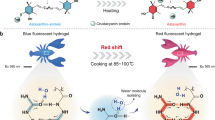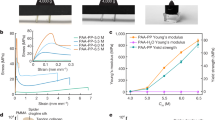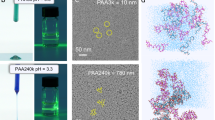Abstract
INTERACTIONS between macromolecules fall into four categories: ionic, hydrophobic, van der Waals and hydrogen bonding. Phase transitions in polymer gels provide a means of studying these interactions. Many gels will undergo reversible, discontinuous volume changes in response to changes in, for example, temperature, gel composition or light irradiation1–5. These transitions result from the competition between repulsive intermolecular forces, usually electrostatic in nature, that act to expand the polymer network, and an attractive force that acts to shrink it. Volume transitions in gels have been observed that are driven by all of the above-mentioned forces except hydrogen bonding (ref 6–10; T.T. et al, unpublished data; H. Inomata et al., personal communication). Here we report on a phase transition in an interpenetrating polymer network of poly(acrylamide) and poly(acrylic acid) that completes this picture—it is controlled by cooperative 'zipping' interactions between the molecules which result from hydrogen bonding. Cooperativity is an essential feature of the interactions, in that independent hydrogen bonds would not provide a sufficient driving force for the transition. A further novel characteristic of this phase transition is that the swelling (in water) is induced by an increase rather than a decrease in temperature.
This is a preview of subscription content, access via your institution
Access options
Subscribe to this journal
Receive 51 print issues and online access
$199.00 per year
only $3.90 per issue
Buy this article
- Purchase on SpringerLink
- Instant access to full article PDF
Prices may be subject to local taxes which are calculated during checkout
Similar content being viewed by others
References
Tanaka, T. Phys. Rev. Lett. 40, 820–823 (1978).
Dusek, K. & Patterson, D. J. Polymer Sci. 6, (A-2), 1209–1216 (1968).
Tanaka, T. et al. Phys. Rev. Lett. 45, 1636–1639 (1980).
Ilavsky, M. Macromolecules 15, 782–788 (1982).
Suzuki, A. & Tanaka, T. Nature 346, 345–347 (1990).
Hirokawa, Y. & Tanaka, T. J. chem. Phys. 81, 6379–6380 (1984).
Otake, K. et al. J. chem. Phys. 91, 1345–1350 (1990).
Hirotsu, S., Hirokawa, Y. & Tanaka, T. J. chem. Phys. 87, 1392–1395 (1987).
Wakayama, M., Umermoto, S., Okui, T. & Sakai, T. Polymer Prep. Japan 38, 3892–3895 (1989).
Myoga, A. & Katayama, S. Polymer Prep. Japan 36, 2852–2853 (1987).
Osada, Y., J. Polymer Sci. Polymer Chem. Ed. 17, 3485–3498 (1979).
Painter, P. C., Graf, J. & Coleman, M. M. J. chem. Phys. 92, 6166–6174 (1979).
Baranovsky, Yu. V., Litmanovich, A. A., Papisov, I. M. & Kabanov, V. A. Europ. Polymer J. 17, 969–979 (1981).
Eustace, D. J., Siano, D. B. & Drake, E. N. J. Appl. Polymer Sci. 35, 707–716 (1988).
Tsuchida, E. & Abe, K. Interaction between Macromolecules in Solution (Springer, Berlin, 1982).
Abe, K. & Koide, M. Macromolecules 10, 1259–1265 (1977).
Gano, T., Bae, Y. H., Jacobs, H. & Kim, S. W. J. Controlled Release 11, 255–265 (1990).
Franks, F. (ed.), Water, A Comprehensive Treaty (Plenum, New York, 1973).
Author information
Authors and Affiliations
Rights and permissions
About this article
Cite this article
Ilmain, F., Tanaka, T. & Kokufuta, E. Volume transition in a gel driven by hydrogen bonding. Nature 349, 400–401 (1991). https://doi.org/10.1038/349400a0
Received:
Accepted:
Issue date:
DOI: https://doi.org/10.1038/349400a0
This article is cited by
-
Morphogenesis of starfish polymersomes
Nature Communications (2023)
-
Fiber-Shaped Soft Actuators: Fabrication, Actuation Mechanism and Application
Advanced Fiber Materials (2023)
-
Double-safety flexible supercapacitor basing on zwitterionic hydrogel: over-heat alarm and flame-retardant electrolyte
Advanced Composites and Hybrid Materials (2022)
-
Lighted up by hydrogen-bonding: luminescence behavior and applications of AIEgen-doped interpenetrating network hydrogel
Science China Chemistry (2021)
-
In situ polymerization approach to cellulose–polyacrylamide interpenetrating network hydrogel with high strength and pH-responsive properties
Cellulose (2019)



